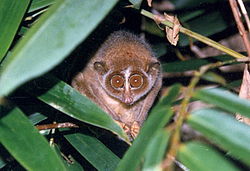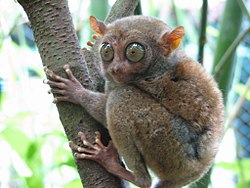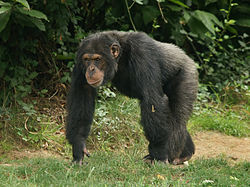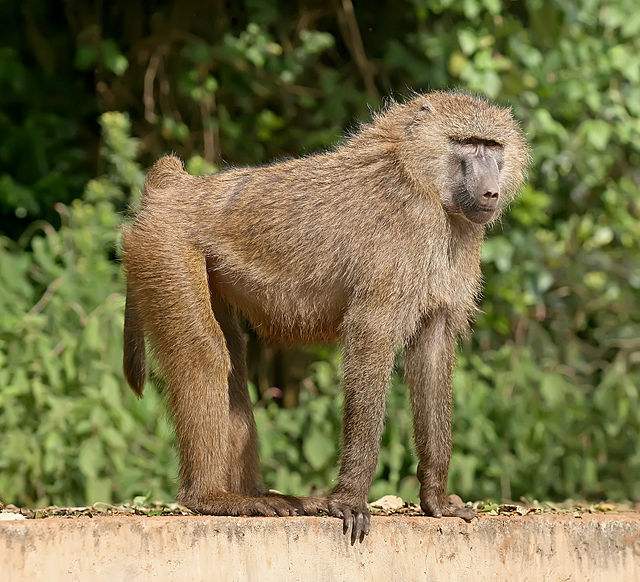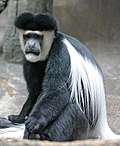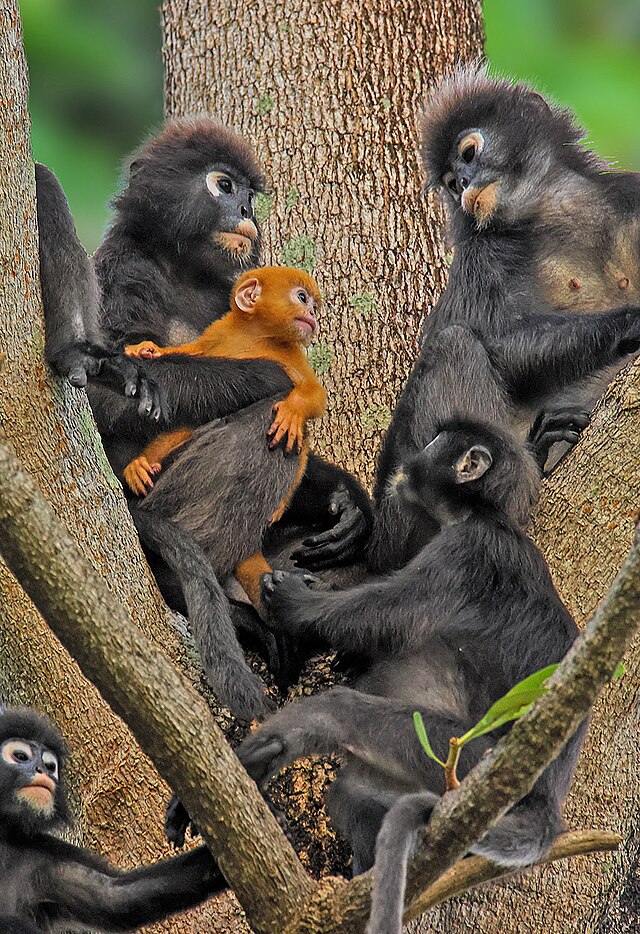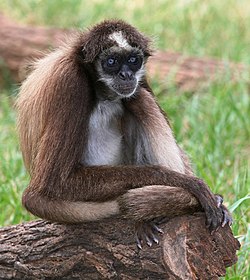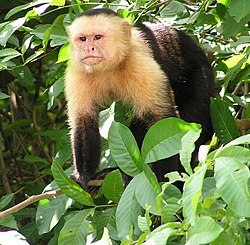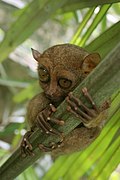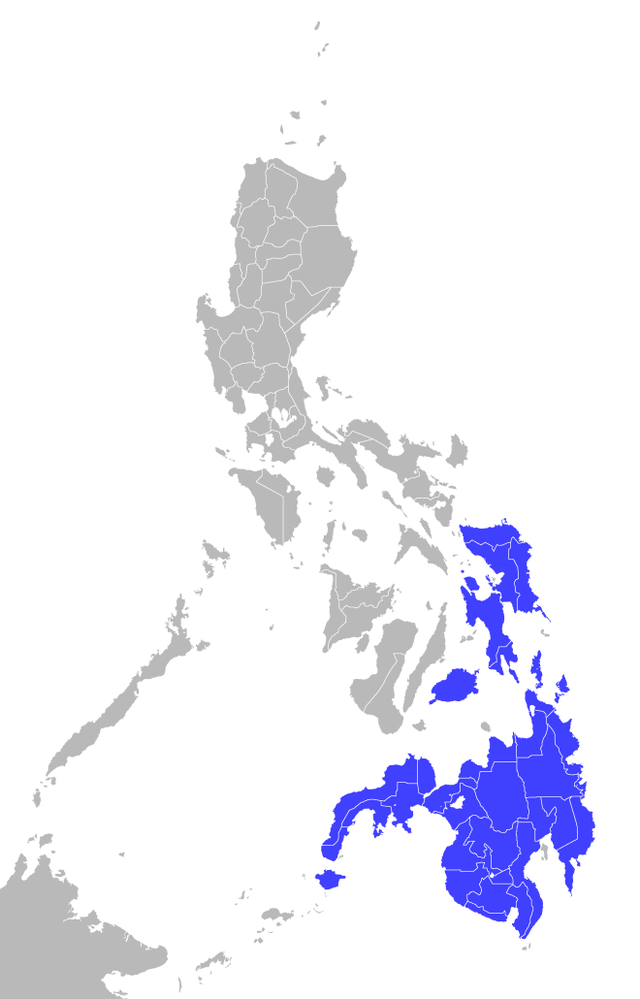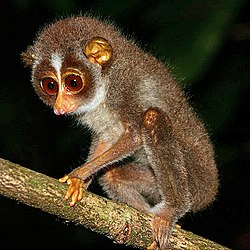Top Qs
Timeline
Chat
Perspective
List of primates
Animals in mammal order Primates From Wikipedia, the free encyclopedia
Remove ads
Primates is a diverse order of placental mammals which includes monkeys, lemurs, galagos, lorisids, tarsiers, and apes (including humans). Members of this order are called primates. The order currently comprises 505 extant species, which are grouped into 81 genera. The majority of primates live in South and Central America, Africa, and southern and Southeast Asia, in a variety of habitats, particularly forests but also including grasslands, savannas, shrublands, wetlands, deserts, and rocky areas. The exception is humans, which have spread worldwide to every biome. Primates come in a variety of body plans but typically feature large brains, a shoulder girdle allowing a large degree of movement in the shoulder joint, dexterous hands, and tails, sometimes prehensile.[1] They range in size from Margot Marsh's mouse lemur, at 8 cm (3 in) plus a 11 cm (4 in) tail, to the eastern gorilla, at 196 cm (77 in), not including limbs. Primates are also the most intelligent animals and non-human primates are recorded to use tools, communicate with gestures and vocalizations, and have complex social systems.[2]
Ring-tailed lemur (Lemur catta)
Red slender loris (Loris tardigradus)
Northern greater galago (Otolemur garnettii)
Philippine tarsier (Carlito syrichta)
Red-faced spider monkey (Ateles paniscus)
Hamadryas baboon (Papio hamadryas)
Chimpanzee (Pan troglodytes)
Humans (Homo sapiens)
Bornean orangutan (Pongo pygmaeus)
Western gorilla (Gorilla gorilla)
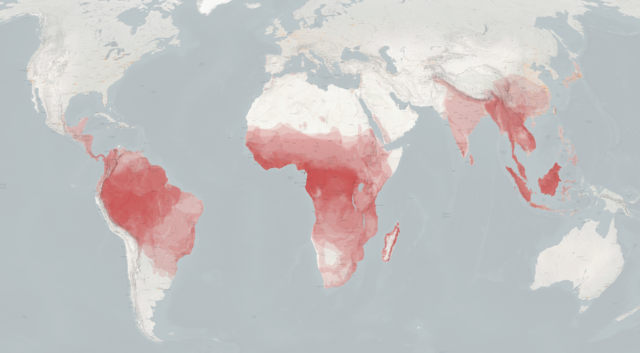
Primates is divided into two suborders: Haplorrhini and Strepsirrhini. The suborders are further subdivided into clades and families. Haplorrhini contains nine families in four major clades: Cercopithecoidea, containing the Old World monkeys of the family Cercopithecidae; Hominoidea, containing the great apes of the family Hominidae and the gibbons of the family Hylobatidae; Platyrrhines, or New World monkeys, divided into the families Aotidae, Atelidae, Callitrichidae, Cebidae, and Pitheciidae and containing night, howler, spider, woolly, capuchin, squirrel, and saki monkeys, marmosets, and tamarins; and Tarsiiformes, containing the tarsier family Tarsiidae. Strepsirrhini is split between two clades: Lemuroidea, divided into the families Cheirogaleidae (dwarf and mouse lemurs), Daubentoniidae (the aye-aye), Indriidae (wooly lemurs, sifakas, and indri), Lemuridae (lemurs), and Lepilemuridae (sportive lemurs); and Lorisoidea, split between the galago family Galagidae and the loris family Lorisidae. The exact organization of the species is not fixed, with many recent proposals made based on molecular phylogenetic analysis. No species have been recorded as going extinct since 1500 CE, but over 200 species, or more than 40 percent of all primates, are considered endangered or critically endangered.
Remove ads
Conventions
The author citation for the species or genus is given after the scientific name; parentheses around the author citation indicate that this was not the original taxonomic placement. Range maps are provided wherever possible; if a range map is not available, a description of the collective range of species in that genera is provided. Ranges are based on the International Union for Conservation of Nature (IUCN) Red List of Threatened Species unless otherwise noted.
Remove ads
Classification
Summarize
Perspective
The order Primates consists of 505 extant species belonging to 81 genera. This does not include hybrid species or extinct prehistoric species. Modern molecular studies indicate that the 81 genera can be grouped into 16 families; these families are divided between two named suborders and are grouped in those suborders into named clades, and some of these families are subdivided into named subfamilies.
Suborder Haplorrhini
- Superfamily Cercopithecoidea
- Family Cercopithecidae (Old World monkeys)
- Subfamily Cercopithecinae (cercopithecine monkeys): 13 genera, 78 species
- Subfamily Colobinae (leaf-eating monkeys): 10 genera, 80 species
- Family Cercopithecidae (Old World monkeys)
- Superfamily Hominoidea (apes)
- Family Hominidae (hominids)
- Family Hylobatidae (gibbons): 4 genera, 20 species
- Parvorder Platyrrhines (New World monkeys)
- Family Aotidae (night monkeys): 1 genus, 11 species
- Family Atelidae
- Subfamily Alouattinae (howler monkeys): 1 genus, 12 species
- Subfamily Atelinae (spider and wooly monkeys): 3 genera, 11 species
- Family Callitrichidae (marmosets and tamarins): 7 genera, 43 species
- Family Cebidae
- Subfamily Cebinae (capuchin monkeys): 2 genera, 11 species
- Subfamily Saimiriinae (squirrel monkeys): 1 genus, 7 species
- Family Pitheciidae
- Subfamily Callicebinae (titi monkeys): 3 genera, 33 species
- Subfamily Pitheciinae (saki monkeys and uakaris: 3 genera, 25 species
- Infraorder Tarsiiformes
- Family Tarsiidae (tarsiers): 3 genera, 14 species
Suborder Strepsirrhini
- Superfamily Lemuroidea (lemurs)
- Family Cheirogaleidae (dwarf and mouse lemurs): 5 genera, 41 species
- Family Daubentoniidae (aye-aye): 1 genus, 1 species
- Family Indriidae (woolly lemurs, sifakas, and indri): 3 genera, 19 species
- Family Lemuridae (lemurs): 5 genera, 21 species
- Family Lepilemuridae (sportive lemurs): 1 genus, 25 species
- Superfamily Lorisoidea
- Family Galagidae (galagos): 6 genera, 19 species
- Family Lorisidae
- Subfamily Lorisinae (lorises): 3 genera, 11 species
- Subfamily Perodicticinae (angwantibos and pottos): 2 genera, 5 species
Remove ads
Primates
Summarize
Perspective
The following classification is based on the taxonomy described by Mammal Species of the World (2005), with augmentation by generally accepted proposals made since using molecular phylogenetic analysis, as supported by both the IUCN and the American Society of Mammalogists.[4]
Suborder Haplorrhini
Superfamily Cercopithecoidea
Family Cercopithecidae
Members of the Cercopithecidae family are called cercopithecids, or colloquially Old World monkeys, and include baboons, colobuses, guenons, lutungs, macaques, and other types of monkeys. Cercopithecidae comprises 158 extant species, divided into 23 genera. These genera are grouped into two subfamilies: Cercopithecinae, or cercopithecine monkeys, containing baboon, guenon, macaque, and other monkey species; and Colobinae, or leaf-eating monkeys, containing colobus, lutung, and other monkey species.
Superfamily Hominoidea
Family Hominidae
Members of the Hominidae family are hominids, or colloquially great apes, and include gorillas, chimpanzees, orangutans, and humans. Hominoidae comprises eight extant species, divided into four genera. These genera are grouped into two subfamilies: Homininae, or African hominids, containing gorillas, chimpanzees, bonobos, and humans; and Ponginae, or Asian hominids, containing orangutans.
Family Hylobatidae
Members of the Hylobatidae family are hylobatids, or colloquially gibbons. Hylobatidae comprises 19 extant species, divided into four genera.
Parvorder Platyrrhines
Family Aotidae
Members of the Aotidae family are aotids, or colloquially night monkeys. Aotidae comprises eleven extant species in a single genus.
Family Atelidae
Members of the Atelidae family are atelids, or colloquially night monkeys, and include howler, spider, woolly, and woolly spider monkeys. Aotidae comprises 24 extant species in 4 genera. It is divided into the subfamilies Alouattinae, or howler monkeys, and Atelinae, or spider and woolly monkeys.
Family Callitrichidae
Members of the Callitrichidae family are callitrichids, and include marmosets, tamarins, and lion tamarins. Callitrichidae comprises 43 extant species in 7 genera.
Family Cebidae
Members of the Cebidae family are cebids, and include capuchin and squirrel monkeys. Cebidae comprises eighteen extant species in three genera, and is divided into the subfamilies Cebinae, or capuchin monkeys, and Saimiriinae, or squirrel monkeys.
Family Pitheciidae
Members of the Pitheciidae family are pitheciids, and include titis, saki monkeys and uakaris. Pitheciidae comprises 55 extant species in 5 genera, and is divided into the subfamilies Callicebinae, or titis, and Pitheciinae, or saki monkeys and uakaris.
Infraorder Tarsiiformes
Family Tarsiidae
Members of the Tarsiidae family are tarsiids, or colloquially tarsiers. Tarsiidae comprises fourteen extant species in three genera.
Suborder Strepsirrhini
Superfamily Lemuroidea
Family Cheirogaleidae
Members of the Cheirogaleidae family are cheirogaleids, and include dwarf, mouse, giant mouse, and fork-marked lemurs. Cheirogaleidae comprises 41 extant species in 5 genera.
Family Daubentoniidae
Members of the Daubentoniidae family are daubentoniids; the family comprises a single extant species, the aye-aye.
Family Indriidae
Members of the Indriidae family are indriids, and include woolly lemurs, sifakas, and indri. Indriidae comprises nineteen extant species in three genera.
Family Lemuridae
Members of the Lemuridae family are lemurids, and include ring-tailed, true, ruffed, and bamboo lemurs. Indriidae comprises 21 extant species in 5 genera.
Family Lepilemuridae
Members of the Lepilemuridae family are lepilemurids, or colloquially sportive lemurs. Lepilemuridae comprises 25 extant species in a single genus.
Superfamily Lorisoidea
Family Galagidae
Members of the Galagidae family are galagids, or colloquially galagos or bush babies. Galagidae comprises nineteen extant species in six genera.
Family Lorisidae
Members of the Lorisidae family are lorisids, and include lorises, pottos and angwantibos. Lorisidae comprises sixteen extant species in five genera, and is divided into the subfamilies Lorisinae, or lorises, and Perodicticinae, or the angwantibos and pottos.
Remove ads
References
Sources
Wikiwand - on
Seamless Wikipedia browsing. On steroids.
Remove ads


